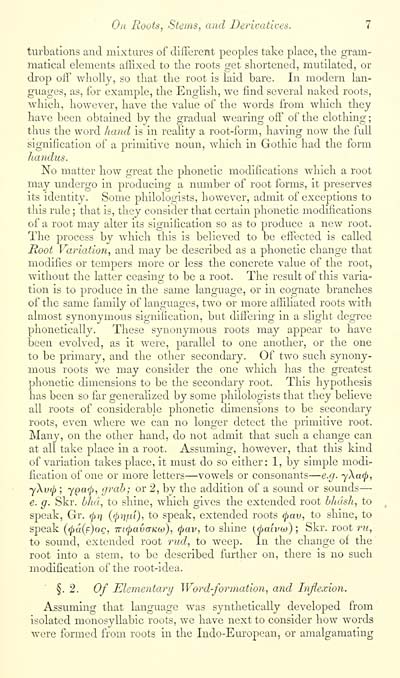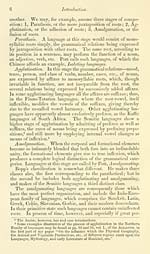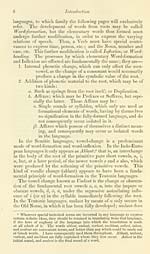Blair Collection > Celtic studies
(37)
Download files
Complete book:
Individual page:
Thumbnail gallery: Grid view | List view

On Roots, Steins, and Dericatlces. 7
turbations and inixtiu'es of clifferent peoples take place, the gram-
matical elements affixed to the roots get shortened, mutilated, or
drop off wholly, so that the root is laid bare. In modern lan-
guages, as, for example, the English, we find several naked roots,
which, however, have the value of the words from which they
have been obtained by the gradual wearing off of the clothing ;
thus the word liand is in reality a root-form, having now the full
signification of a primitive noun, Avliich in Gothic had the form
handus.
No matter how great the phonetic modifications which a root
may imdergo in producing a number of root forms, it preserves
its identity. Some philologists, however, admit of exceptions to
this rule ; that is, they consider that certain phonetic modifications
of a root may alter its signification so as to produce a new root.
The process by which this is believed to be effected is called
Root Variation, and may be described as a phonetic change that
modifies or tempers more or less the concrete value of the root,
without the latter ceasing to be a root. The result of this varia-
tion is to produce in the same language, or in cognate branches
of the same fiimily of languages, two or more affihated roots with
almost synonymous signification, but differing in a slight degree
phonetically. These synonymous roots may appear to have
been evolved, as it were, parallel to one another, or the one
to be primary, and the other secondary. Of two such synony-
mous roots we may consider the one which has the greatest
phonetic dimensions to be the secondary root. This hypothesis
has been so far generalized by some philologists that they believe
all roots of considerable phonetic dimensions to be secondary
roots, even where we can no longer detect the primitive root.
Many, on the other hand, do not admit that such a change can
at all take place in a root. Assuming, however, that this kind
of variation takes place, it must do so either: 1, by simple modi-
fication of one or more letters — vowels or consonants — e.g. jXacp,
y\v<j) ; ypa(p, grab; or 2, by the addition of a somid or sounds —
e. g. Skr. bhd, to shine, which gives the extended root bhdsh, to
speak, Gr. 0j/ {(piifii), to speak, extended roots 0av, to shine, to
speak (0a(F)oc, TTKpavaKw), (pav, to shine {(paivw); Skr. root int,
to sound, extended root rud, to weep. In the change of the
root into a stem, to be described further on, there is no such
modification of the root-idea.
§.2. Of Elementarij Word-formation, and Inflexion.
Assuming that language was synthetically developed from
isolated monosyllabic roots, we have next to consider how words
were formed from roots in the Indo-European, or amalgamating
turbations and inixtiu'es of clifferent peoples take place, the gram-
matical elements affixed to the roots get shortened, mutilated, or
drop off wholly, so that the root is laid bare. In modern lan-
guages, as, for example, the English, we find several naked roots,
which, however, have the value of the words from which they
have been obtained by the gradual wearing off of the clothing ;
thus the word liand is in reality a root-form, having now the full
signification of a primitive noun, Avliich in Gothic had the form
handus.
No matter how great the phonetic modifications which a root
may imdergo in producing a number of root forms, it preserves
its identity. Some philologists, however, admit of exceptions to
this rule ; that is, they consider that certain phonetic modifications
of a root may alter its signification so as to produce a new root.
The process by which this is believed to be effected is called
Root Variation, and may be described as a phonetic change that
modifies or tempers more or less the concrete value of the root,
without the latter ceasing to be a root. The result of this varia-
tion is to produce in the same language, or in cognate branches
of the same fiimily of languages, two or more affihated roots with
almost synonymous signification, but differing in a slight degree
phonetically. These synonymous roots may appear to have
been evolved, as it were, parallel to one another, or the one
to be primary, and the other secondary. Of two such synony-
mous roots we may consider the one which has the greatest
phonetic dimensions to be the secondary root. This hypothesis
has been so far generalized by some philologists that they believe
all roots of considerable phonetic dimensions to be secondary
roots, even where we can no longer detect the primitive root.
Many, on the other hand, do not admit that such a change can
at all take place in a root. Assuming, however, that this kind
of variation takes place, it must do so either: 1, by simple modi-
fication of one or more letters — vowels or consonants — e.g. jXacp,
y\v<j) ; ypa(p, grab; or 2, by the addition of a somid or sounds —
e. g. Skr. bhd, to shine, which gives the extended root bhdsh, to
speak, Gr. 0j/ {(piifii), to speak, extended roots 0av, to shine, to
speak (0a(F)oc, TTKpavaKw), (pav, to shine {(paivw); Skr. root int,
to sound, extended root rud, to weep. In the change of the
root into a stem, to be described further on, there is no such
modification of the root-idea.
§.2. Of Elementarij Word-formation, and Inflexion.
Assuming that language was synthetically developed from
isolated monosyllabic roots, we have next to consider how words
were formed from roots in the Indo-European, or amalgamating
Set display mode to: Large image | Transcription
Images and transcriptions on this page, including medium image downloads, may be used under the Creative Commons Attribution 4.0 International Licence unless otherwise stated. ![]()
| Early Gaelic Book Collections > Blair Collection > Celtic studies > (37) |
|---|
| Permanent URL | https://digital.nls.uk/75771589 |
|---|
| Description | A selection of books from a collection of more than 500 titles, mostly on religious and literary topics. Also includes some material dealing with other Celtic languages and societies. Collection created towards the end of the 19th century by Lady Evelyn Stewart Murray. |
|---|
| Description | Selected items from five 'Special and Named Printed Collections'. Includes books in Gaelic and other Celtic languages, works about the Gaels, their languages, literature, culture and history. |
|---|

